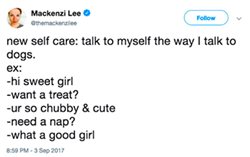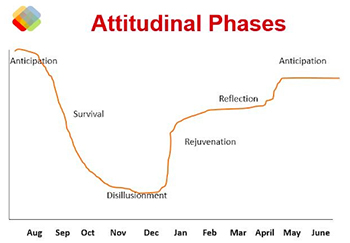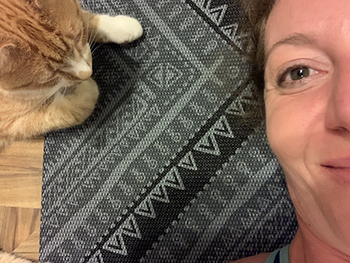October 22, 2019
 This is the second in a series of guest blogs by the 2019-20 Michigan Regional Teachers of the Year. Amanda Clemons, an English and AP psychology teacher at Manistee Middle/High School in Manistee Public Schools, is the Region 2 winner. You can find her on Twitter at @clemteach.
This is the second in a series of guest blogs by the 2019-20 Michigan Regional Teachers of the Year. Amanda Clemons, an English and AP psychology teacher at Manistee Middle/High School in Manistee Public Schools, is the Region 2 winner. You can find her on Twitter at @clemteach.

Lately my social media has been inundated with calls for self-love. I enjoy reading the tweets and memes as I lie in bed at night, waiting for the numbers to turn to at least 9:01 so I can go to sleep without the nagging thought that going to bed before 9 means I’ve reached the point of no return – middle age.
Teachers understand all too well the importance of self-care. We recognize when our students aren’t getting enough sleep, are overwhelmed, are stressed or are dealing with social problems. We can recognize when the members of our circle start to descend into disillusionment.

But we’re also the first people to run ourselves into the ground. One glance at my personal planner would send most people to the nearest bed, covers pulled immediately over their heads, for a three-hour nap. Over the past two weeks, there have been Homecoming activities: supervising float building, window painting, assembly games, powderpuff football, bonfires, dance decorating, football game, dance chaperone, dance cleanup; and school activities: lesson planning, staff meeting, parent teacher conferences, paper grading, district leadership team meeting – honestly, I can keep going. Need a nap yet?
Anyway, last January I made a commitment to myself that I would start each and every day with yoga. As of October 1, I made it to the mat with my friend Adriene Mishler (
@yogawithadriene) 260 out of 275 days. I’m a much better human being this year; I attribute it partly to my yoga practice. During the day, I am able to answer 1,958 questions before it feels as if my head will explode. When I reach that point, I stop and breathe. Breathe lots of love in; breathe lots of love out.

Yoga has provided me a way to connect to my past: My mom and I watched “Yoga, Lilias and You” on PBS every day when I was a kid. Then, I didn’t appreciate the ease with which my body moved into Lizard, forearms on the floor. Now, I appreciate that my arms have stopped falling asleep when I’m in bed at night. Plus, I love the fact that Ernie occasionally joins in for a morning session.
Although my students keep insisting that I’m “not
that old,” I think a lot more about my health in general. I can’t take being able to bend over and tie my shoes for granted because some day I may not be able to. I think about things like increased immunity to diseases, increased blood flow, better posture, stronger muscles and joints, lower blood pressure, increased energy, better sleep, lower blood sugar and improving balance (no one wants a broken hip) – all benefits of yoga.
And cognitively, the practice of yoga has been shown to increase self-awareness, lessen violent behaviors, increase empathy, increase stress management and increase concentration, and has a correlation to higher self-esteem. And it is these benefits that bring this thought train back on track. Because self-love and self-care is not just for adults. We have a responsibility as teachers to model for our students life-long learning, appropriate social interactions and a million other things. But we also have a responsibility to teach them how to love themselves – to show students what it looks like to love oneself.
Loving oneself and being aware of emotions is the first step to awareness of other people’s feelings and an important step in understanding prosocial behavior. I think we can all agree that bullying is an issue in schools, and many programs I’ve experienced focus on helping students feel brave enough to tell someone about the behavior, focusing on victim care.
But yoga meditation and mindfulness provide a tool to help bullies. According to Psychology Today
, “bullies lack prosocial behavior, are untroubled by anxiety and do not understand others’ feelings. They misread the intentions of others, often imputing hostility in neutral situations.” So, let’s teach them yoga! Or, more specifically, let’s help children make the connection between mindfulness, yoga breathing, self-awareness and empathy.
As a matter of fact, research out of the University of Wisconsin-Madison finds that compassionate meditation actually changes the brain physically. These changes make people more empathetic to the emotions, moods and mental states of others. Since one behavioral correlation of bullies is a lack of empathy for others’ feelings, it seems clear that a prevention program that includes meditation and yoga would benefit these students. As a matter of fact, it will benefit all students. It’s not as easy as Mountain Pose, but it’s do-able.
I recognize that not all teachers can take the time to do 30 minutes of yoga with students every day. I, myself, have to get through “The Great Gatsby” this month. Although, honestly, given the current research, Tom Buchanan might benefit from some daily yoga and meditation.
Despite classroom time constraints, teachers can use yoga to do self-exploration. And, once we practice self-love, we can help our students practice it, too. Why not incorporate some deep breathing into those bell ringer exercises? Why not start class with some meditation techniques? Teachers need to be advocates for our students--including bullies and victims.
I’m pretty sure that everyone in our society will be happier and healthier if we can focus on inhaling lots of love in, exhaling lots of love out. Love for ourselves. Love for others. Love for the world.
Namaste.